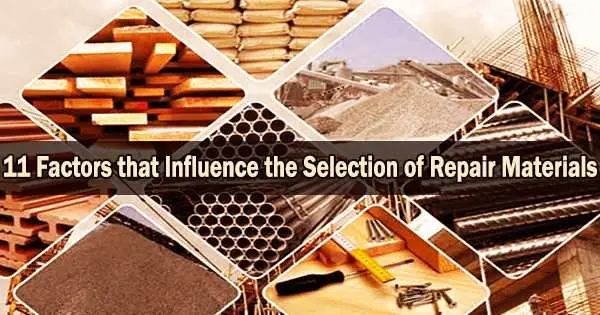To choose the most suitable, compatible, and affordable repair materials, a variety of criteria including strength, durability, thermal coefficient of thermal expansion, permeability, low dry shrinkage, chemical and electrical properties, curing, and cost must be taken into account.
This guarantees a successful and long-lasting repair job that gives the intended strength recovery. However, it is necessary to look into the availability of pertinent supplies, tools, and professional workers.
11 Factors Affecting the Selection of Repair Materials
Strength
Nearly all repairs and protective tasks require strong bonds and compressive forces. The foundation material’s strength and the strength of the repair materials should be about equal or slightly higher. To ensure a good and consistent flow of stress and strain through the materials, this is done.
However, if the base and repair materials are both very strong, the repair material would break prematurely as a result of an uneven distribution of loads and strains.
The restoration material should adhere satisfactorily to the underlying concrete surface. The use of glue, a surface interlocking system, mechanical bonding, or a combination of these can all be considered as appropriate techniques to increase the bond strength if there are any doubts.
Durability
The repair material must hold up under the exposure circumstances that the defective structure is subjected to. It should exhibit sufficient resistance to chemical attack as well as resistance to all types of energy, including heat and ultraviolet rays.
Coefficient of Thermal Expansion
To prevent excessive stresses from being passed to the bonding interface or the substrate, the repair material must have an expansion coefficient that is almost identical to that of the original concrete. In especially for overlays, thermal incompatibility may result in failure at the interface or within the lower strength material.
Low Drying Shrinkage
The bond between the repair material and the underlying concrete surface must have the least amount of dry shrinkage feasible because the concrete base’s shrinkage has already been fully finished.
The link between the repair material and the concrete basis would be compromised if this requirement were not met, which would result in the formation of surface delamination or shrinkage cracks. Steel bars would experience corrosion as a result of shrinkage cracks that permit the entry of air and moisture.
The limits for cement-based repair materials for 28-day and ultimate drying shrinkage are 400 and 1000 millionths, respectively.
Utilizing low w/c combinations, the largest practicable size and volume of course aggregate, shrinkage-reducing admixtures, or construction techniques that minimize the potential for shrinkage can all help to reduce the shrinkage of cementitious repair materials. Curing of the materials is very critical especially if the thicknesses are smaller.
Permeability
To avoid the entrance of aggressive chemicals such carbon dioxide, water, oxygen, and industrial gases and vapors, the permeability of the repair materials should be minimal. This is to protect the reinforcement from corrosion.
Large patches, overlays, or coatings made of impermeable materials, however, run the risk of trapping moisture that rises through the underlying concrete between the concrete and the impermeable repair material.
This moisture may result in bond failure or may make freezing and thawing much more difficult.
Modulus of Elasticity
The repair material’s elastic modulus ought to be comparable to that of the concrete that already exists.
A lower modulus of the repair material is preferred in nonstructural repairs to aid in the relaxation of tensile tensions brought on by restrained drying shrinkage.
The maximum modulus of elasticity for cement-based repair materials is generally taken equal to 24 GPa.
Chemical Properties
A pH close to 12 (alkaline environment) of repair material is better for corrosion protection to embedded reinforcement. Otherwise, cathodic protection or reinforcement coatings may provide additional protection for the existing reinforcement.
Electrical Properties
High electrical resistance materials tend to keep corrosive concrete away from places that have been repaired.
Corrosion activity around the perimeter of the repair region may rise due to differences in electrical potential between the repair material and the original concrete, leading to premature collapse. This is commonly referred to as the anodic ring or halo effect.
Color and Texture Properties
The color and texture of the repair material must not significantly differ from the adjacent surface when fixing architectural concrete surfaces. On-site tests may be conducted prior to starting the actual repair work.
Curing Requirement
To reduce post-repair care, repair materials with minimal or low curing requirements are very desirable. Repair materials that require a strong curing action could suffer from poor curing, which would prevent them from reaching their intended strengths.
Cost of Repair Material
It is preferable to choose inexpensive repair materials, but this strategy shouldn’t come at the expense of the materials’ usefulness.
















